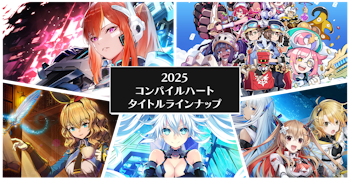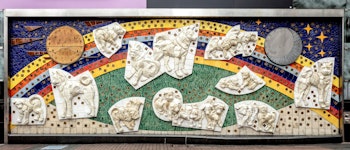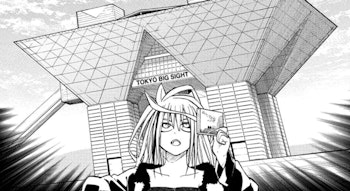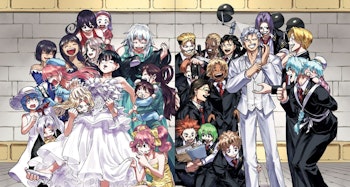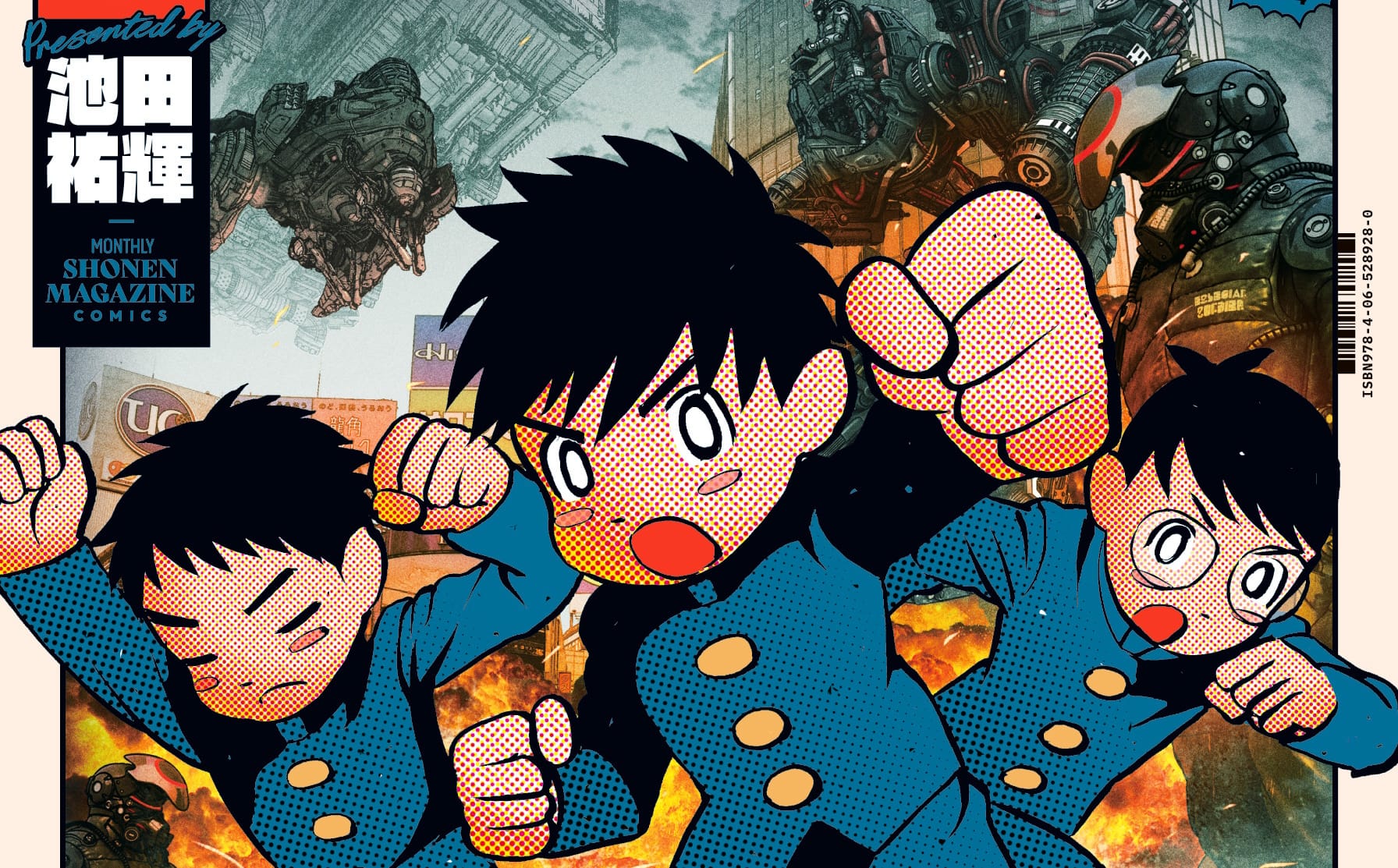
In 1964, Canadian communications theorist Marshall McLuhan coined the phrase “The medium is the message.” Although McLuhan originally intended this as a call to study the medium in which information is communicated as well as the information itself, the phrase can be more broadly applied to media in the sense that the specific medium in which a story is told is just as important as the story itself. Just as movies can tell stories in ways novels can’t, manga too has its own set of peculiarities that if used correctly, can make for an entirely unique experience that you can’t replicate anywhere else.
No series better encapsulates this than Thunder 3.
Currently serialized in Kodansha’s Monthly Shonen Magazine since 2022, Thunder 3 is an extraordinary debut work by apparent rookie Yuki Ikeda. While it does have some concerning political implications, it stands tall as an example of a story that could only be told in manga, as well as one that serves to enthrall and excite. The conclusion is simple: if you’re a fan of manga and you aren’t reading this series, then you’re missing out.
A Dimension-Hopping Premise
Pyontaro Tezuka is your average middle school student. He’s not particularly smart or clever, he doesn’t do any sports or club activities, and his development is lagging a little bit behind some of his peers. Probably the only thing interesting in his life is the fact that his dad is a manga artist, but not a particularly famous one. Sometimes he looks up pictures of boobs on his phone out of simple curiosity.
His two best friends are called Tsubame and Hiroshi. They all live in the same cul-de-sac and they’re all quite small, so some have taken to calling them the “Small 3” when they walk together. They all have a tiny crush on a high schooler who plays guitar outside the station every night, even though they’d never admit it. Oh, and Pyontaro also has a little sister called Futaba who steals his clothes while he’s in the bath and always wants to sleep in the same bed as him - even though she goes potty in the middle of the night.
All of that changes when Futaba accidentally enters a doorway to another world.

In many ways, the panel above should convey the core premise of Thunder 3 much better than any words ever could, but here goes: what if characters from a slice of life manga ended up in another series? The true genius of this core concept is that most readers would assume that the crude way in which Yuki Ikeda renders Pyontaro’s everyday life is simply how this manga looks, until the introduction of hyper-realistic backgrounds suddenly suggests otherwise. It’s a kind of rug pull that could only be achieved in manga, even if an anime could approximate it to a certain degree.
What’s more, the idea of having crudely-drawn slice of life characters suddenly thrust into another, more realistic series is consistently developed in subsequent chapters. Not only do the Small 3’s phones and coins not work in this universe as they’re too cartoon-like, their origins from another world gives them fabulous powers once they’re transported to a different setting. As one character remarks: they’re like Superman.
The Slow, Measured, Not Very Fast Invasion
It’s a good thing that the Small 3 have special powers, because the doorway that Futaba wanders into leads to an alternate Earth that is currently in the process of being invaded by creatures from outer space. Herein lies the second part of Thunder 3’s premise: what if slice of life characters ended up in another world and had to fight aliens? Although this might sound awesome, this is also where Yuki Ikeda ends up engaging with some uncomfortable subtext.
Just a couple of months prior to Futaba’s arrival on the other Earth, giant alien spaceships appeared in the sky all over the world. Despite some initial panic, the media very quickly announced that the aliens had already made contact with the governments of the world and that they come in peace. The sight of such advanced machinery on the horizon was unusual at first, but eventually became normal as everyone continued their everyday lives. The ships just hung there, not moving or making a sound.
And then the invasion started.

Slowly but surely, giant alien creatures began to appear one by one on the streets. Like with the spaceships, people were shocked and scared at first, but none of the aliens appeared very interested in interacting with humans. Even if you tried to start a conversation with them, they’d just ignore you, so everyone started ignoring them too. The same went for the hulking military figures with huge, futuristic guns and the giant bipedal mechs. Everyone just continued on with their important little lives.
This is the sorry state of Japanese society that Yuki Ikeda depicts in the early chapters of Thunder 3. It’s definitely true to a certain extent: what once appears abnormal can quickly become routine the longer it goes on, but the series makes a conscious effort to link this to the rise of social media as people film Pyontaro and friends with their smartphones while grotesquely repeating the word yabai (“OMG!”). Furthermore, the slow intrusion of the aliens on Japanese everyday life makes for an unfortunate metaphor about multiculturalism.
Multiculturalism & National Revival
There’s a particular moment in Thunder 3 volume 2 that really stuck with me. As secondary protagonist Teiichi Segami is wandering around Shibuya listlessly, hoping that someone will do something about the aliens, he notes that the price of cup noodles has risen to 2000 yen while the cinema has stayed the same. He then also sees two aliens heading out of Bic Camera with many shopping bags on their arms before witnessing a horrific incident where a giant alien mech crushes a car with a child in it on Scramble Crossing.
Although the scene of a bipedal robot walking down Japan’s most famous intersection isn’t one you usually see in everyday life, the debate surrounding increased tourism and the weak value of the yen has been raging ever since some stores decided to start charging non-residents higher prices to compensate for lower domestic purchasing power. In general, the idea that foreigners are nothing but a nuisance who don’t respect societal norms and even end up pricing out locals as businesses attempt to take advantage of the exchange rate has permeated some sections of Japanese society, reflected by the rise of fringe candidates such as “Joker” politician Kawai Yusuke.
Thunder 3 cannot escape from reflecting this.

To start off with, the concept of an alien invasion always brings to mind real world incursions and conquests. Sometimes this can take on an anti-imperialist character, but Thunder 3 definitely comes across as more nationalistic. After witnessing a JSDF pilot throw away his life to take down an alien warship in chapter 8, Segami remarks that “The Japanese are starting to fight back… I’ve never seen people act like this.” In this sense, Yuki Ikeda paints the grotesque indifference of Japanese society towards the aliens as a national affliction, one which can only be overcome through heroic sacrifice.
The overt fascistic leanings of this are obvious. Just as military power and resistance against an antagonistic force are intertwined here, so are the two concepts throughout history in such regimes. Things only get more hairy once you consider that the resistance Segami joins is made up of many former JSDF and police officers: instead of being portrayed as tools of the state, Thunder 3 prefers to paint them as heroes protecting Japan’s national honor. Anyone who approaches this series with a critical eye will inevitably come to the same conclusion.
Thunder 3 is Simply the Best Manga Right Now
Nevertheless, all of these uncomfortable metaphors weren’t ultimately enough to take away from my enjoyment of Thunder 3. Even as I noted the broader political implications of the series’ characters and setting, I still found myself utterly captivated by the medium-defining premise and white knuckle action. One moment in volume five actually made me stand up and fist pump the air - if that’s not a compliment, I don’t know what is.
In many ways, it feels like Yuki Ikeda accidentally ended up writing a manga with nationalistic and fascistic implications. Pretty much all of the more questionable subtext comes from the story surrounding Segami and the resistance, so it’s all in the name of making the fight against the aliens as compelling as possible. What’s more, Ikeda mentions Gantz as a primary influence in the foreword to volume four: Hiroya Oku’s series is also one that can come across as reactionary while simultaneously delivering some of the rawest action in the business.
At the end of the day, whether or not you can look past Thunder 3’s flaws to appreciate what lies within depends on your personal experience. Many will immediately turn away when hearing about the themes presented in this article, but others will be utterly captivated from chapter one by the core concept. The only thing I can do is express my honest belief: manga lovers everywhere owe it to themselves to at least check this one out.
Thunder 3 volume 1 releases in English via Kodansha on November 5.




